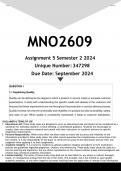MNO2609
Assignment 5 Semester 2 2024
Unique Number: 347298
Due Date: September 2024
QUESTION 1
1.1 Explaining Quality
Quality can be defined as the degree to which a product or service meets or exceeds customer
expectations. It starts with understanding the specific needs and desires of the customer and
ensures that these requirements are met throughout the production or service delivery process.
Quality involves not only the functionality and reliability of a product but also its durability, safety,
and ease of use. When quality is consistently maintained, it leads to customer satisfaction,
DISCLAIMER & TERMS OF USE
1. Educational Aid: These study notes are designed to serve as educational aids and should not be considered as a
substitute for individual research, critical thinking, or professional guidance. Students are encouraged to
conduct their own extensive research and consult with their instructors or academic advisors for specific
assignment requirements.
2. Personal Responsibility: While every effort has been made to ensure the accuracy and reliability of the
information provided in these study notes, the seller cannot guarantee the completeness or correctness of all
the content. It is the responsibility of the buyer to verify the accuracy of the information and use their own
judgment when applying it to their assignments.
3. Academic Integrity: It is crucial for students to uphold academic integrity and adhere to their institution's
policies and guidelines regarding plagiarism, citation, and referencing. These study notes should be used as a
tool for learning and inspiration, but any direct reproduction of the content without proper acknowledgment and
citation may constitute academic misconduct.
4. Limited Liability: The seller of these study notes shall not be held liable for any direct or indirect damages,
losses, or consequences arising from the use of the notes. This includes, but is not limited to, poor grades,
academic penalties, or any other negative outcomes resulting from the application or misuse of the information
prov
]
, For additional support +27 81 278 3372
QUESTION 1
1.1 Explaining Quality
Quality can be defined as the degree to which a product or service meets or exceeds
customer expectations. It starts with understanding the specific needs and desires of the
customer and ensures that these requirements are met throughout the production or service
delivery process. Quality involves not only the functionality and reliability of a product but
also its durability, safety, and ease of use. When quality is consistently maintained, it leads
to customer satisfaction, which in turn can enhance brand reputation and customer loyalty.
1.2 Commercial Advantages of Focusing on Customer Loyalty
Focusing on customer loyalty can provide several commercial advantages, including:
• Increased Revenue: Loyal customers are more likely to make repeat purchases,
contributing to a steady revenue stream.
• Lower Marketing Costs: Retaining existing customers is generally more cost-
effective than acquiring new ones, reducing overall marketing expenses.
• Word-of-Mouth Referrals: Satisfied, loyal customers often become advocates for
the brand, bringing in new customers through positive word-of-mouth
recommendations.
• Higher Profit Margins: Loyal customers may be willing to pay a premium for a
trusted brand, allowing the company to maintain higher profit margins.
• Improved Business Stability: A loyal customer base provides a reliable foundation
for the business, making it more resilient to market fluctuations.
1.3 Technique to Assess Customer Satisfaction
One of the most appropriate techniques for assessing customer satisfaction is the Net
Promoter Score (NPS). NPS is a straightforward metric that asks customers to rate on a
scale of 0 to 10 how likely they are to recommend the company’s product or service to
others. Based on their responses, customers are classified into three categories: Promoters
(9-10), Passives (7-8), and Detractors (0-6). The NPS is calculated by subtracting the
percentage of Detractors from the percentage of Promoters. This technique is widely used





